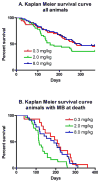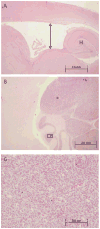Perigestational dietary folic acid deficiency protects against medulloblastoma formation in a mouse model of nevoid basal cell carcinoma syndrome
- PMID: 23909730
- PMCID: PMC3771499
- DOI: 10.1080/01635581.2013.804940
Perigestational dietary folic acid deficiency protects against medulloblastoma formation in a mouse model of nevoid basal cell carcinoma syndrome
Abstract
Hereditary nevoid basal cell carcinoma syndrome (NBCCS) is caused by PTCH1 gene mutations that result in diverse neoplasms including medulloblastoma (MB). Epidemiological studies report reduced pediatric brain tumor risks associated with maternal intake of prenatal vitamins containing folic acid (FA) and FA supplements specifically. We hypothesized that low maternal FA intake during the perigestational period would increase MB incidence in a transgenic NBCCS mouse model, which carries an autosomal dominant mutation in the Ptch1 gene. Female wild-type C57BL/6 mice (n = 126) were randomized to 1 of 3 diets with differing FA amounts: 0.3 mg/kg (low), 2.0 mg/kg (control), and 8.0 mg/kg (high) 1 mo prior to mating with Ptch1 (+/-) C57BL/6 males. Females were maintained on the diet until pup weaning; the pups were then aged for tumor development. Compared to the control group, offspring MB incidence was significantly lower in the low FA group (Hazard Ratio = 0.47; 95% confidence interval 0.27-0.80) at 1 yr. No significant difference in incidence was observed between the control and high FA groups. Low maternal perigestational FA levels may decrease MB incidence in mice genetically predisposed to tumor development. Our results could have implications for prenatal FA intake recommendations in the presence of cancer syndromes.
Figures




Similar articles
-
Novel PTCH1 mutations in Japanese Nevoid basal cell carcinoma syndrome patients: two familial and three sporadic cases including the first Japanese patient with medulloblastoma.J Hum Genet. 2011 Apr;56(4):277-83. doi: 10.1038/jhg.2011.2. Epub 2011 Mar 3. J Hum Genet. 2011. PMID: 21368767
-
Two cases of nevoid basal cell carcinoma syndrome associated with meningioma caused by a PTCH1 or SUFU germline mutation.Fam Cancer. 2012 Dec;11(4):565-70. doi: 10.1007/s10689-012-9548-0. Fam Cancer. 2012. PMID: 22829011
-
Multifocal desmoplastic medulloblastoma in an african-american child with nevoid basal cell carcinoma (gorlin) syndrome. Case report.J Neurosurg. 2006 Oct;105(4 Suppl):315-20. doi: 10.3171/ped.2006.105.4.315. J Neurosurg. 2006. PMID: 17328283
-
Ptc1 heterozygous knockout mice as a model of multi-organ tumorigenesis.Cancer Lett. 2006 Mar 28;234(2):124-34. doi: 10.1016/j.canlet.2005.03.047. Epub 2005 May 31. Cancer Lett. 2006. PMID: 15925443 Review.
-
SHH desmoplastic/nodular medulloblastoma and Gorlin syndrome in the setting of Down syndrome: case report, molecular profiling, and review of the literature.Childs Nerv Syst. 2016 Dec;32(12):2439-2446. doi: 10.1007/s00381-016-3185-0. Epub 2016 Jul 21. Childs Nerv Syst. 2016. PMID: 27444290 Review.
Cited by
-
Folic acid supplementation in pregnancy and implications in health and disease.J Biomed Sci. 2014 Aug 19;21(1):77. doi: 10.1186/s12929-014-0077-z. J Biomed Sci. 2014. PMID: 25135350 Free PMC article. Review.
-
Global metabolomics study on the pathogenesis of pediatric medulloblastoma via UPLC- Q/E-MS/MS.PLoS One. 2023 Jun 15;18(6):e0287121. doi: 10.1371/journal.pone.0287121. eCollection 2023. PLoS One. 2023. PMID: 37319142 Free PMC article.
-
Perinatal folate levels do not influence tumor latency or multiplicity in a model of NF1 associated plexiform-like neurofibromas.BMC Res Notes. 2023 Oct 17;16(1):275. doi: 10.1186/s13104-023-06515-8. BMC Res Notes. 2023. PMID: 37848948 Free PMC article.
-
The impact of folic acid supplementation on gestational and long term health: Critical temporal windows, benefits and risks.Porto Biomed J. 2017 Nov-Dec;2(6):315-332. doi: 10.1016/j.pbj.2017.05.006. Epub 2017 Jul 12. Porto Biomed J. 2017. PMID: 32258789 Free PMC article. Review.
References
-
- Surveillance, Epidemiology, and End Results (SEER) Program. SEER*Stat Database: Incidence - SEER 13 Regs Research Data, Nov 2010 Sub (1973–2008) <Single Ages to 85+, Katrina/Rita Population Adjustment> - Linked To County Attributes - Total U.S., 1969–2009 Counties. National Cancer Institute, DCCPS, Surveillance Research Program, Cancer Statistics Branch; ( www.seer.cancer.gov) released April 2012, based on the November 2011 submission.
-
- Bowers DC, Liu Y, Leisenring W, McNeil E, Stovall M, Gurney JG, Robison LL, Packer RJ, Oeffinger KC. Late-occurring stroke among long-term survivors of childhood leukemia and brain tumors: a report from the Childhood Cancer Survivor Study. J Clin Oncol. 2006;24(33):5277–82. - PubMed
-
- Neglia JP, Robison LL, Stovall M, Liu Y, Packer RJ, Hammond S, Yasui Y, Kasper CE, Mertens AC, Donaldson SS, Meadows AT, Inskip PD. New primary neoplasms of the central nervous system in survivors of childhood cancer: a report from the Childhood Cancer Survivor Study. J Natl Cancer Inst. 2006;98(21):1528–37. - PubMed
-
- Ness KK, Mertens AC, Hudson MM, Wall MM, Leisenring WM, Oeffinger KC, Sklar CA, Robison LL, Gurney JG. Limitations on physical performance and daily activities among long-term survivors of childhood cancer. Ann Intern Med. 2005;143(9):639–47. - PubMed
Publication types
MeSH terms
Substances
Grants and funding
LinkOut - more resources
Full Text Sources
Other Literature Sources
Medical
Miscellaneous
